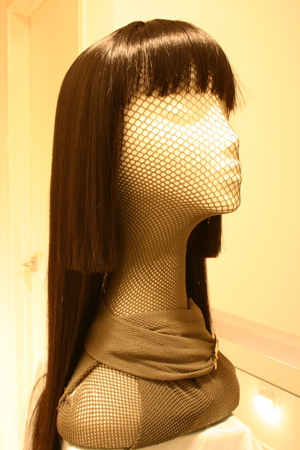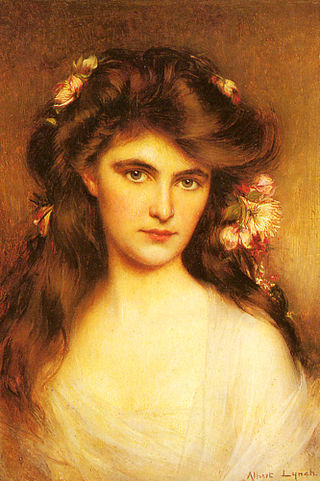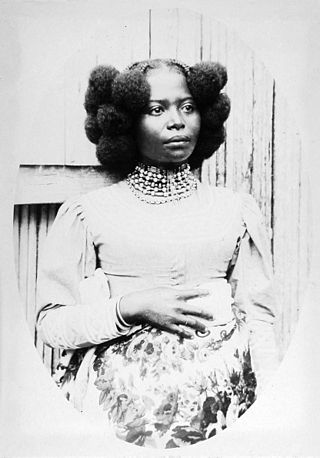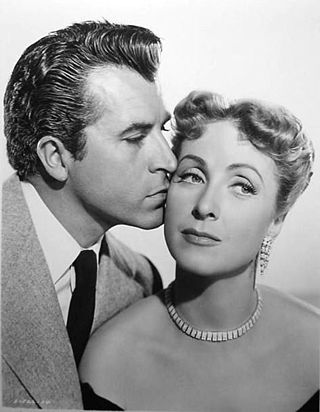
A hairstyle, hairdo, haircut or coiffure refers to the styling of hair, usually on the human head but sometimes on the face or body. The fashioning of hair can be considered an aspect of personal grooming, fashion, and cosmetics, although practical, cultural, and popular considerations also influence some hairstyles.

A wig is a head covering made from human or animal hair, or a synthetic imitation thereof. The word is short for "periwig". Wigs may be worn to disguise baldness, to alter the wearer's appearance, or as part of certain professional uniforms.

A ponytail is a hairstyle in which some, most, or all of the hair on the head is pulled away from the face, gathered and secured at the back of the head with a hair tie, clip, or other similar accessory and allowed to hang freely from that point. It gets its name from its resemblance to the tail of a pony.

The afro is a hair style created by combing out natural growth of afro-textured hair, or specifically styled with chemical curling products by individuals with naturally curly or straight hair. The hairstyle can be created by combing the hair away from the scalp, dispersing a distinctive curl pattern, and forming the hair into a rounded shape, much like a cloud or puff ball.

In the context of hairstyles, the usage of the term pigtail shows considerable variation. The term may refer to a single braid, but is more frequently used in the plural ("pigtails") to refer to twin braids on opposite sides of the head. Sometimes, the term "pigtails" applies whether or not the hair is braided, but there is not widespread agreement on this.
Artificial hair integrations, more commonly known as hair extensions, hair weaves, and fake hair add length and fullness to human hair. Hair extensions are usually clipped, glued, or sewn on natural hair by incorporating additional human or synthetic hair. These methods include tape-in extensions, clip-in or clip-on extensions, micro/nano rings, fusion method, weaving method, and wigs.

A bouffant is a type of puffy, rounded hairstyle characterized by hair raised high on the head and usually covering the ears or hanging down on the sides.

The conk was a hairstyle popular among African-American men from the 1920s up to the early-to-mid 1960s. This hairstyle called for a man with naturally "kinky" hair to have it chemically straightened using a relaxer called congolene, an initially homemade hair straightener gel made from the extremely corrosive chemical lye which was often mixed with eggs and potatoes. The applier had to wear gloves and the solution timed just right on the applicant's head and then thoroughly rinsed out with cold water to avoid chemical burns. The desired outcome was for the newly straightened hair to be easily styled in the popular "conk" style of that era.

1840s fashion in European and European-influenced clothing is characterized by a narrow, natural shoulder line following the exaggerated puffed sleeves of the later 1820s and 1830s. The narrower shoulder was accompanied by a lower waistline for both men and women.

Fashion in the years 1750–1775 in European countries and the colonial Americas was characterised by greater abundance, elaboration and intricacy in clothing designs, loved by the Rococo artistic trends of the period. The French and English styles of fashion were very different from one another. French style was defined by elaborate court dress, colourful and rich in decoration, worn by such iconic fashion figures as Marie Antoinette.

Fashion in the period 1650–1700 in Western clothing is characterized by rapid change. The style of this era is known as Baroque. Following the end of the Thirty Years' War and the Restoration of England's Charles II, military influences in men's clothing were replaced by a brief period of decorative exuberance which then sobered into the coat, waistcoat and breeches costume that would reign for the next century and a half. In the normal cycle of fashion, the broad, high-waisted silhouette of the previous period was replaced by a long, lean line with a low waist for both men and women. This period also marked the rise of the periwig as an essential item of men's fashion.

Fashion in the period 1700–1750 in European and European-influenced countries is characterized by a widening silhouette for both men and women following the tall, narrow look of the 1680s and 90s. This era is defined as late Baroque/Rococo style. The new fashion trends introduced during this era had a greater impact on society, affecting not only royalty and aristocrats, but also middle and even lower classes. Clothing during this time can be characterized by soft pastels, light, airy, and asymmetrical designs, and playful styles. Wigs remained essential for men and women of substance, and were often white; natural hair was powdered to achieve the fashionable look. The costume of the eighteenth century, if lacking in the refinement and grace of earlier times, was distinctly quaint and picturesque.

Bangs or a fringe are strands or locks of hair that fall over the scalp's front hairline to cover the forehead, usually just above the eyebrows, though can range to various lengths. While most people cut their bangs straight, they may also shape them in an arc or leave them ragged.

Kinky hair, also known as afro-textured hair, is a human hair texture prevalent in the indigenous populations of many regions with hot climates, mainly sub-Saharan Africa, some areas of Melanesia, and Australia. Each strand of this hair type grows in a repeating pattern of small contiguous kinks. These numerous kinks make kinky hair appear denser than straight, wavy, and curly hair types.
The hairstyles adopted in the Christian tradition have varied widely over time as well as between locations, social and economic classes, ethnicities, denominations, and the cultures from which Christians have emerged. Among the Clergy and consecrated religious hair styles have also varied between orders and positions with in the church. These variations, along with the regulation of hair styles by church dress code, enabled hair styles to convey information about their wearers role in the church and their relationship to faith.

Hairstyle fashion in Rome was ever changing, and particularly in the Roman Imperial Period there were a number of different ways to style hair. As with clothes, there were several hairstyles that were limited to certain people in ancient society. Styles are so distinctive they allow scholars today to create a chronology of Roman portraiture and art; we are able to date pictures of the empresses on coins or identify busts depending on their hairstyles.

African-American hair or Black hair refers to hair types, textures, and styles that are linked to African-American culture, often drawing inspiration from African hair culture. It plays a major role in the identity and politics of Black culture in the United States and across the diaspora. African-American hair often has a kinky hairy texture, appearing tightly coiled and packed. Black hair has a complex history, culture, and cultural impact, including its relationship with racism.

Fashion in the twenty years between 1775 and 1795 in Western culture became simpler and less elaborate. These changes were a result of emerging modern ideals of selfhood, the declining fashionability of highly elaborate Rococo styles, and the widespread embrace of the rationalistic or "classical" ideals of Enlightenment philosophes.

In the Western world, the 1950s were a decade known for experimentation with new styles and culture. Following World War II and the austerity years of the post-war period, the 1950s were a time of comparative prosperity, which influenced fashion and the concept of glamour. Hairstylists invented new hairstyles for wealthy patrons. Influential hairstylists of the period include Sydney Guilaroff, Alexandre of Paris and Raymond Bessone, who took French hair fashion to Hollywood, New York and London, popularising the pickle cut, the pixie cut and bouffant hairstyles.

Laid edges, also called slayed edges or swooped edges, refers to a style of arranging the fine "baby hairs" at the edge of the hairline into flat, decorative waves or swirls. The style is sometimes referred to as simply baby hairs, and originates with African-American fashions of the 1990s.


















